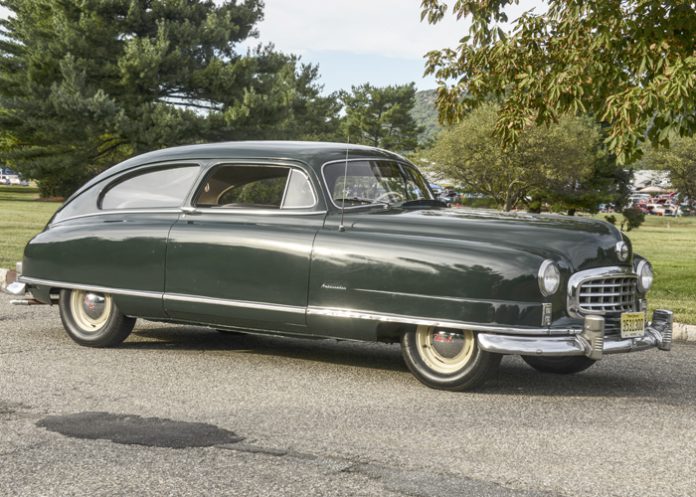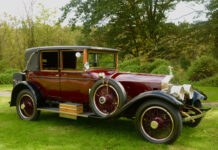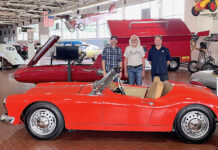By Jay Hirsch
The 1949 Nash was not only a completely redesigned car from the 1941–1948 pre-war Nash models, but it also had new engineering. A unit body replaced the body on-frame-chassis of the 1941–1948 Nash.
Nash President George Mason wanted a new car for the American car world in 1949. Nils Wahlberg, vice president of engineering, had access to a wind tunnel during WWII and firmly believed cars of the future should be aerodynamic to achieve the many benefits of aerodynamically designed cars. From the money Nash Motors made during the war from its contracts with the government George Mason put that money into producing the entirely new wind tunnel designed full size 1949 Nash.
The 1950 is basically the same car as the 1949 except for the availabity of the GM Hydramatic transmission. If the Hydramatio was ordered, the starter button was eliminated. “No starter button to push, no gears to shift, no clutch pedal,” as Nash wrote in its sales brochure.
The Nash was “full skirted” to go along with the streamlined aero design. As the turning circle would have been more difficult with the full-skirted look, Nash got around this by narrowing the front track by three inches. The front track is 55 inches while the rear track is 60.5 inches
The new Nash also had the industry’s first one-piece, curved windshield and curved rear window. The curved one piece windshield not only enhanced side viewing but also eliminated the blind spot created by the two-piece windshield with the post in the middle. The new Nash body was called the “Airflyte” and came as a two-door (seen here) and also in a four-door sedan. There were two series: the Statesman, which was 201 inches long and rode on a 112 inch wheelbase, and the slightly more upscale Ambassador, which was 210 inches in length and had a 121 inch wheelbase.
A feature of the two-door Airflyte was the reclining front seats that could be turned into a bed. Reclining front seats were an option on the four-door models. Optional on all Nash models was the air-liner reclining seat on the passenger side that had five positions. The reclining front seats that made a bed just went down; the passenger side did not have any relining positions unless ordered and was a “fitting companion to the twin beds.”
Following wind-tunnel tests at the University of Wichita, Nash could boast in its 1950 brochure that “The Nash Airflyte moves through the air with 20.7% less air-drag than the average of all other leading makes of cars tested. Other cars used as much as 51% more power . . . at speeds ranging from 30 M.P.H. upwards. The new Nash Airflyte for 1950 requires 11 horsepower less at 80 miles per hour for air drag alone than the average of other modern automobiles.”
In the 1950 sales brochure Nash boasts about its new aero design: “You slip through the air with 20% less wind resistance than the average car of current design. You’re realizing economy never before — 25 miles per gallon at highway speed in a big, six-passenger Nash Airflyte.” Highway speed in 1950 was between 50-60 mph.
The 1950 Nash Airflyte Ambassador seen here is an original car. It has never been repainted, and the interior has never been replaced. Anthony and his wife, Anita, are basically “Cadillac people” but like all cars. A friend of Anthony’s told him about this Ambassador, and as Anthony always liked the look of the 1949–1951 “bathtub” Nash (this is what many people called the aero look of the Nash), Anthony went to see it. The car was everything his friend said it was. It did need a good tune up and replacing rubber components—brake lines, etc. But the car was well taken care of as far as being garaged and was used a few times a year. Being a Nash the price was very reasonable. The 1949–1951 Nash models falls into the “collectible car” category. It is an easy way to get into the old car world and have fun at the same time. As Anthony said: “When is the last time you saw a 1949–1951 Nash at a car event? And those reclining seats always draw attention.”
The Nash has an OHV 234.5/3.8-liter inline six-cylinder engine, a column mounted manual four-speed transmission with overdrive, is 62 inches tall, weighs 3,500 pounds and rides on 7.10 x 15 tires, all at a cost of $2,219 in 1950. This put the Ambassador in the same league as a Buick Super, Chrysler Royal, Desoto, Olds 88 and few other American mid-range cars.
Being an “independent” Nash-Kelvinator found it difficult to compete with the “Big Three” (Chrysler, Ford and GM) and so joined with Hudson in 1954 to become American Motors and concentrate more on its smaller and more successful car in sales the Nash Rambler.
There were 145,782 Nash Airflyte’s sold in 1950. In 1952 Nash received a new design created by the Italian design firm PininFarina. •



